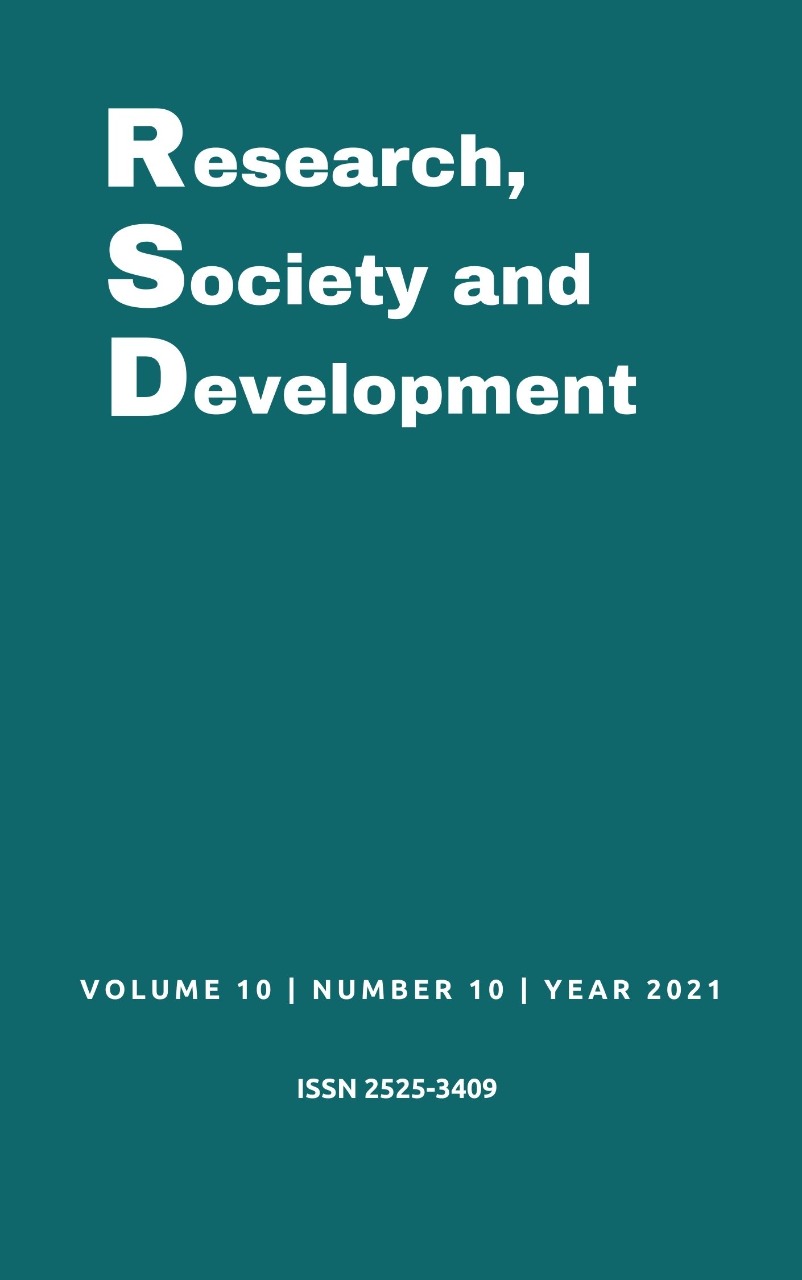Moldagens em prótese sobre implantes / moldeira fechada ou aberta?
DOI:
https://doi.org/10.33448/rsd-v10i10.18749Palavras-chave:
Implantes dentários, Moldeira aberta, Moldeira fechada, Prótese dentária.Resumo
Como objetivo principal deste estudo tem-se: ampliar os conhecimentos sobre as técnicas de moldagem em moldeiras abertas e fechadas. Como objetivos secundários, propõe-se: estudar sobre as próteses sobre implantes; caracterizar as distinções entre as moldeiras abertas e fechadas; ampliar os conhecimentos sobre as situações mais adequadas para o uso de cada estilo de moldeira (aberta ou fechada). O presente estudo trata-se de um levantamento bibliográfico descritivo e qualitativo, utilizando-se assim de referenciais teóricos extraídos de livros, artigos científicos, monografias, teses, dissertações revistas e sites eletrônicos que retratem o tema proposto. Nos últimos anos, a demanda para a reabilitação de perdas dentárias com implantes, se popularizou. No atual estágio de desenvolvimento que as próteses sobre implantes atingiram, estas são consideradas como sendo as melhores opções de tratamento, sendo consideradas como de alto padrão dentro das próteses dentarias. O principal objetivo de uma moldagem em prótese sobre implantes é registrar com exatidão o posicionamento dos componentes na boca e dos tecidos moles, bem como das estruturas adjacentes ao espaço edêntulo, utilizando-se assim componentes específicos para transferência, bem como análogos metálicos do dispositivo presente em boca, seja pilares ou implantes. Entre as técnicas de moldagens temos a técnica com moldeira aberta e com moldeira fechada. Portanto, a escolha entre moldeira aberta ou fechada, será baseada nas características dos componentes e reabilitação que serão realizados. Ambas as técnicas possuem suas vantagens, no entanto, cada uma é indicada para casos específicos. Neste sentido, a escolha se baseará na demanda individual de cada paciente.
Referências
Agarwal, S., Ashok, V., & Maiti, S. (2020). Open- or Closed-Tray Impression Technique in Implant Prosthesis: A Dentist's Perspective. Journal of long-term effects of medical implants, 30(3), 193–198. https://doi.org/10.1615/JLongTermEffMedImplants.2020035933
Amin, S., Weber, H. P., Finkelman, M., El Rafie, K., Kudara, Y., & Papaspyridakos, P. (2017). Digital vs. conventional full-arch implant impressions: a comparative study. Clinical oral implants research, 28(11), 1360–1367. https://doi.org/10.1111/clr.12994
Bezerra, R. M. et al. (1999). Microestrutura e resistência à corrosão do Ti c.p. soldado a laser utilizando em prótese sobre implantes. Elétrica Química, 24, 113-124.
Farias Neto, A., Carreiro, A. F. P. & Rizzatti-Barbosa, C. M. A. (2011). Prótese parcial removível no contexto da odontologia atual. Odontologia Clínico-Científica,10 (2), 125-8.
Fernandes JR., R. C. et al. (2014). Implantodontia: próteses totais fixas sobre implante com carga imediata em mandíbula. Revista de Iniciação Científica da Universidade Vale do Rio Verde, 4 (1), 76-93.
Gerhardt, T. E. & Silveira, D. T. (2009). Métodos de pesquisa. Editora da UFRGS.
Kim, K. R., Seo, K. Y., & Kim, S. (2019). Conventional open-tray impression versus intraoral digital scan for implant-level complete-arch impression. The Journal of prosthetic dentistry, 122(6), 543–549. https://doi.org/10.1016/j.prosdent.2018.10.018
Kono, T. T. L. D. V. (2014). Especialização em Odontologia (Monografia). Universidade Estadual de Campinas.
Liu, D. Y., Cader, F. N., Abduo, J., & Palamara, J. (2019). Accuracy of Different Implant Impression Techniques: Evaluation of New Tray Design Concept. Journal of prosthodontics: official journal of the American College of Prosthodontists, 28(2), e682–e687. https://doi.org/10.1111/jopr.12733
Marotti, J., Tortamano, P. & Wolfart, S. (2012). Moldagem em implantodontia. Revista de Pós-Graduação, 19 (3), 113-21.
Mendes, L. G. A., Rohenkohl, J.H. & Mendes, M. O. A. (2010). Prótese sobre implantes: cimentada versus parafusada. Unoesc & Ciência, 1 (2), 157-164.
Pimenta, M. H. G., Silva, R. S. S. & Poluha, R. L. (2019). Moldagem Em Prótese Sobre Implante: Revisão De Literatura. Revista UNINGÁ, 56 (S5), 37-42.
Rocha, S. S. et. al. (2013). Próteses Totais Fixas Tipo Protocolo Bimaxilares. Relato de Caso. Revista Odontologia do Brasil Central, 21 (60), 21-7.
Santiago J. R. et al. (2010). Implantes dentais curtos: alternativa conservadora na reabilitação bucal. Revista de Cirurgia e Traumatologia Buco-maxilo-facial, 10 (2), 67-76.
Silva, M. M. et. al. (2008). Técnicas de moldagem em prótese sobre implantes. Revista de Odontologia da UNESP, 37 (4), 301-8.
Souza, S. C. et al. (2021). Análise comparativa entre diferentes técnicas de união de transferentes de moldagem utilizadas em prótese sobre implantes cone morse. Arch Health Invest, 10 (3), 461- 6.
Telles, D. (2009). Prótese total: convencional e sobre implantes. Santos.
Vargas, F. F. (2017). Especialização em Odontologia (Dissertação). Universidade Federal de Pelotas.
Wolfart, S., & Yilmaz, B. (2019). A technique for facilitating open-tray implant impressions. The Journal of prosthetic dentistry, 122(4), 417–419. https://doi.org/10.1016/j.prosdent.2019.06.017
Downloads
Publicado
Edição
Seção
Licença
Copyright (c) 2021 Patrícia Nunes da Rocha; Marcelo Dias Moreira de Assis Costa; Lia Dietrich

Este trabalho está licenciado sob uma licença Creative Commons Attribution 4.0 International License.
Autores que publicam nesta revista concordam com os seguintes termos:
1) Autores mantém os direitos autorais e concedem à revista o direito de primeira publicação, com o trabalho simultaneamente licenciado sob a Licença Creative Commons Attribution que permite o compartilhamento do trabalho com reconhecimento da autoria e publicação inicial nesta revista.
2) Autores têm autorização para assumir contratos adicionais separadamente, para distribuição não-exclusiva da versão do trabalho publicada nesta revista (ex.: publicar em repositório institucional ou como capítulo de livro), com reconhecimento de autoria e publicação inicial nesta revista.
3) Autores têm permissão e são estimulados a publicar e distribuir seu trabalho online (ex.: em repositórios institucionais ou na sua página pessoal) a qualquer ponto antes ou durante o processo editorial, já que isso pode gerar alterações produtivas, bem como aumentar o impacto e a citação do trabalho publicado.


